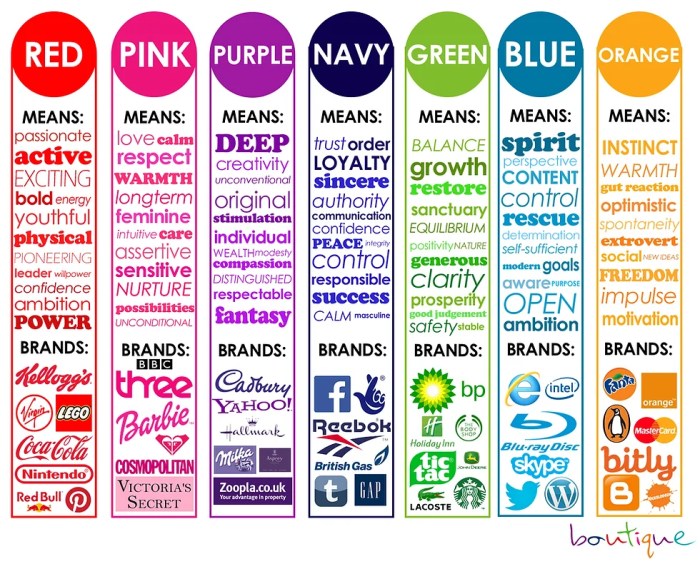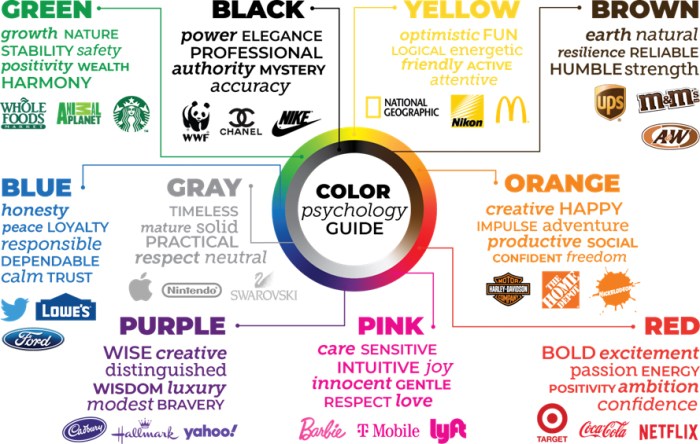Understanding the Impact of Brand Colors brings a fresh perspective on how colors influence consumer behavior, brand recognition, and cultural significance. Dive into this colorful world with a mix of knowledge and style that’s sure to captivate.
Let’s explore the various facets of brand colors and their profound effects on branding strategies and consumer perceptions.
Psychological Impact of Brand Colors
Color psychology plays a crucial role in how consumers perceive and interact with brands. Different colors have the power to evoke specific emotions and associations, influencing purchasing decisions and brand loyalty.
Red: Boldness and Passion
Red is often associated with energy, passion, and urgency. Brands like Coca-Cola and Target use red in their logos to convey excitement and boldness, encouraging action from consumers.
Blue: Trust and Dependability, Understanding the Impact of Brand Colors
Blue is commonly linked to trust, security, and professionalism. Companies like Facebook and IBM utilize blue to establish reliability and credibility in their branding, creating a sense of trust among their audience.
Yellow: Optimism and Cheerfulness
Yellow is often associated with happiness, optimism, and creativity. Brands like McDonald’s and IKEA incorporate yellow in their branding to evoke feelings of joy and positivity, attracting customers with a cheerful vibe.
Cultural Significance of Colors in Branding
Colors can have different meanings and interpretations across cultures. For example, while white signifies purity and simplicity in Western cultures, it represents mourning and death in some Eastern societies. Understanding the cultural significance of colors is essential for brands to effectively communicate their message and resonate with diverse audiences.
Importance of Consistent Brand Color

Maintaining consistent brand colors across all platforms is crucial for establishing a strong brand identity and increasing brand recognition. When a brand uses the same colors consistently in its logo, website, marketing materials, and products, it helps consumers associate those colors with the brand. This leads to better brand recall and increased trust and loyalty among customers.
Significance of Brand Color Consistency
Consistency in brand colors creates a sense of familiarity and reliability for consumers. It helps to differentiate a brand from its competitors and allows for easier identification in a crowded marketplace. By using consistent colors, a brand can convey its values, personality, and messaging effectively, making it more memorable and impactful.
- One example of a brand that has effectively leveraged consistent color schemes is Coca-Cola. The use of red and white colors in their logo, packaging, and advertising has made their brand instantly recognizable worldwide.
- Another great example is Starbucks, which uses green as its primary brand color. This consistency has helped them build a strong brand image associated with quality, sustainability, and community.
- Netflix is also known for its consistent use of red in its branding, creating a strong visual identity that is easily identifiable by consumers.
Color Preferences Across Different Demographics: Understanding The Impact Of Brand Colors

Color preferences can vary significantly among different age groups, genders, and cultural backgrounds. Understanding these variations is crucial for effective branding strategies that resonate with target audiences.
Age Groups
- Younger generations, such as Gen Z and Millennials, often prefer bold and vibrant colors like bright blues, greens, and pinks.
- Middle-aged individuals may lean towards more muted and sophisticated tones like navy blue, deep red, and earthy hues.
- Seniors tend to gravitate towards classic and timeless colors such as black, white, and shades of gray.
Gender Impact on Color Choices
- Studies have shown that men generally prefer primary colors like blue, green, and black, while women are more drawn to pastel shades like pink, purple, and light blue.
- However, these preferences are not set in stone and can vary based on individual tastes and cultural influences.
Cultural Background Influence
- Cultural background plays a significant role in shaping color preferences, as different cultures ascribe varying meanings to colors.
- For example, in Western cultures, white symbolizes purity and innocence, while in some Eastern cultures, it represents mourning and death.
- It’s essential for brands to consider the cultural significance of colors when targeting diverse global markets to avoid unintended misinterpretations.
Utilizing Color Contrast in Branding
When it comes to branding, color contrast plays a crucial role in enhancing readability and visual appeal. The right color combinations can make your brand stand out and leave a lasting impression on your audience.
Importance of Color Contrast
Color contrast is essential for ensuring that your brand is easily recognizable and memorable. By using contrasting colors effectively, you can create visual interest and draw the viewer’s attention to key elements of your branding.
- Choose colors that complement each other: Selecting colors that are opposite each other on the color wheel can create a striking contrast that grabs attention.
- Consider readability: Ensure that your text is easily readable against the background color by using high contrasting colors.
- Highlight important elements: Use contrasting colors to emphasize important information or calls to action in your branding materials.